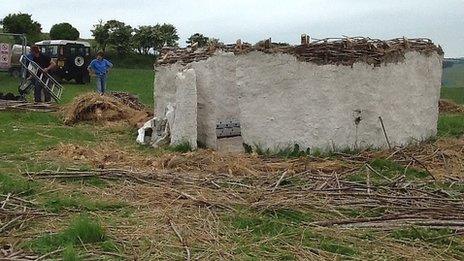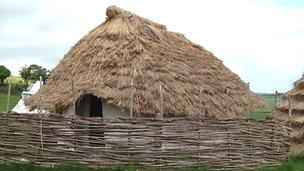Archaeologists demolish Neolithic houses built at Old Sarum
- Published

One hut has been left partially intact as an ongoing experiment into the erosion of prehistoric buildings over time
Three Neolithic houses built at Old Sarum to test out prehistoric building techniques have been demolished.
The prototype huts, made of chalk and straw daub and wheat-thatched roofing, were based on a settlement found at Durrington Walls near Stonehenge.
Project leader Luke Winter said: "It took nine weeks to put them up and about three days to take them down - so it's been quite quick."
The huts are due to be re-built at Stonehenge visitor centre next January.
The temporary Neolithic huts were completed and open to the public during the two May bank holidays.
But last week the volunteers who built them began to dismantle the reconstructed buildings.
Despite the dwellings being "experimental and temporary", Mr Winter said he had not expected the demolition to be emotional.
"We're scientists so I didn't think it would be," he said.
"But it is the first time I've built something and taken it down almost immediately."
'Erosion experiment'
Based on the foundations of buildings, discovered as part of a large settlement under earthworks 3km (2 miles) from the stone circle, one hut has been left partially intact.

It took volunteers nine weeks to build the temporary Neolithic huts
"We've removed the roof that's it and we've left the walls intact and the floor to see how they erode over time," said Mr Winter.
"It's an ongoing experiment to try and find out if Durrington Walls fell down or was taken down."
Having learnt from building the prototypes, the recreated Neolithic huts are due to be re-built at the new visitor centre at Stonehenge next year.
The buildings will form part of an "interactive and experiential" external exhibition at the 3,500-year-old World Heritage site.
- Published6 May 2013
- Published24 April 2013
- Published16 April 2013
- Published24 April 2013
- Published2 October 2012